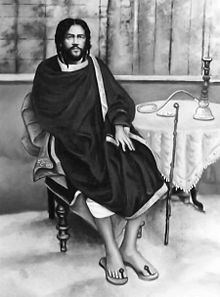
Back স্বামী নিগমানন্দ Assamese স্বামী নিগমানন্দ Bengali/Bangla Nigamananda Paramahansa French स्वामी निगमानन्द परमहंस Hindi ନିଗମାନନ୍ଦ ପରମହଂସ OR நிகாமானந்தா பரமஹன்சா Tamil నిగమానంద పరమహంస Tegulu
Swami Nigamananda Saraswati | |
|---|---|
 (Paramahansa Shrimad Swami Nigamananda Saraswati Deva) | |
| Personal | |
| Born | Nalinikanta Chattopadhyay 18 August 1880 Kutabpur, Nadia, Bengal, British India |
| Died | 29 November 1935 (aged 55) |
| Religion | Hinduism |
| Nationality | Indian |
| School | Vedanta |
| Organization | |
| Order | Self-realization |
| Philosophy | Advaita Vedanta Bhakti yoga Tantra |
| Religious career | |
| Guru | Bamakhepa, Sachidananda Saraswati, Sumerudas Ji aka Koot Hoomi, Gouri Maa |
| Honors | Paramahansa, Sadguru |
My dear children! Life in the household is beset with many trials and tribulations. In spite of all these turmoils it has one advantage to provide – it can bring opportunities for realization of God and self
| Part of a series on |
| Advaita |
|---|
 |
|
|
| Part of a series on |
| Hinduism |
|---|
 |
Swami Nigamananda Paramahansa (born Nalinikanta Chattopadhyay; 18 August 1880[1] – 29 November 1935[2]) was an Indian yogi, guru and mystic in Eastern India.[3][4][5][6] He is associated with the Shakta tradition and a spiritual master of vedanta, tantra, yoga and prema or bhakti.[7][8][9][10][11] His followers referred him as Thakura.
Nigamananda was born into a Bengali Brahmin family in the hamlet of Kutabpur in Nadia district (at present, Meherpur district Bangladesh). He was a sannyasi from Adi Shankar's dashanami sampradaya. After his ordination as a sannyasi, he came to be known as Paribrajakacharya Paramahansa Srimat Swami Nigamananda Saraswati Deva.[2]
Nigamananda achieved siddhi (perfection) in four different sadhanas (spiritual disciplines): tantra, gyan, yoga and prema.[12][13] Based on these experiences, he wrote five Bengali language books: Brahmacarya Sadhana (ब्रह्मचर्य साधन), Yogi Guru (योगिगुरु), Gyani Guru (ज्ञानीगुरु), Tantrika Guru (तांत्रिकगुरु), and Premik Guru (प्रेमिकगुरु).[14][15][16] Nigamananda reportedly experienced the state of Nirvikalpa Samadhi.[17]
In 1912, on the eve of Akshaya Tritaya, an event took place with the laying of the foundation of Shanti Ashram at Kokilamukh, Assam. Within the ashram, Thakur himself founded the space known as the Gurubrhama Gaadi, which served as a focal point for devotees. Adherents from any religious tradition could come together to engage in their spiritual practices.
As an ascetic affiliated with the title of Saraswati under the Sringeri Math, Thakur named his ashram as "Saraswat Math". This nomenclature supported his spiritual lineage and also conveyed his reverence for the goddess Saraswati.
After retiring from Saraswata Math, Nigamananda spent the last fourteen years of his life in Puri. Durga Charan Mohanty, a school student, met him at Nilachala Kutir in 1930 and recognized him as Sadguru.[18]
- ^ Moni Bagchee (1987). Sadguru Nigamananda: a spiritual biography. Assam Bangiya Saraswat Math. p. 43. Retrieved 9 June 2011.
- ^ a b Banik, Nandadulal (2012). "Paramahansha, Nigamananda". In Islam, Sirajul; Jamal, Ahmed A. (eds.). Banglapedia: National Encyclopedia of Bangladesh (Second ed.). Asiatic Society of Bangladesh.
- ^ Paramahamsa Prajnanananda (15 August 2006). My Time with the Master. Sai Towers Publishing. pp. 25–. ISBN 978-81-7899-055-2. Retrieved 18 March 2011.
- ^ Sher Singh; S. N. Sadhu (1991). Indian books in print. Indian Bureau of Bibliographies. p. 572. ISBN 978-81-85004-46-4. Retrieved 2 April 2011.
- ^ Glory of India. Sadguru-Nigamananda. Motilal Banarsides. 1987. p. 98. Retrieved 16 July 2013.
- ^ Prof. Shrikant Prasoon (28 July 2009). Indian saints and sages. Pustak Mahal. p. 57. ISBN 978-81-223-1062-7. Retrieved 1 April 2011.
- ^ Sri Chinmoy (January 1997). Jardin Del Alma. Editorial Sirio, S.A. pp. 119–. ISBN 978-84-7808-230-8.
- ^ Mohan Lal (1 January 2006). The Encyclopaedia Of Indian Literature (Volume Five (Sasay To Zorgot). Sahitya Akademi. pp. 3961–. ISBN 978-81-260-1221-3. Retrieved 18 March 2011.
- ^ Prafulla Chandra Bhanja Deo; Jitāmitra Prasāda Siṃhadeba (2007). A Tantric scholar, and the British wrath on Bastar State: historical documentation relating to Rajkumar Prafulla Chandra Bhanja Deo, and Swami Nigamananda Saraswati. Punthi Pustak. pp. 4, 13, 20. ISBN 978-81-86791-66-0. Retrieved 9 June 2011.
- ^ Chandra Bhanu Satpathy (1 July 2001). Shirdi Sai Baba and other perfect masters. Sterling Publishers Pvt. Ltd. pp. 717–. ISBN 978-81-207-2384-9. Retrieved 1 April 2011.
- ^ Narasingha Prosad Sil (1991). Rāmakṛṣṇa Paramahaṁsa: a psychological profile. BRILL. pp. 92–. ISBN 978-90-04-09478-9. Retrieved 1 April 2011.
- ^ Moni Bagchee (1987). Sadguru Nigamananda: a spiritual biography. Assam Bangiya Saraswat Math. p. 105. Retrieved 17 March 2011.
- ^ David R. Kinsley (1979). The divine player: a study of Kṛṣṇa līlā. Motilal Banarsidass. pp. 296–. ISBN 978-0-89684-019-5. Retrieved 15 March 2011.
- ^ List of Books-Page:102, Brahamcharya Sadhana, Yogi Guru, Gyani Guru, Tantrika Guru, Premika Guru, (Ami ki Chai) at Religious movements in modern Bengal By Benoy Gopal Ray Visva-Bharati, 1965
- ^ Premika Guru, Bangla 4th Edition Archived 15 August 2011 at the Wayback Machine By West Bengal Public Library Network
- ^ Nigamananda (1926). Yogi Guru - 7th ed (in Bengali). Saraswat Math, Garohill Yogashram. hdl:10689/3826.
- ^ Moni Bagchee (1987). "Swami Nigamananda's Nirvikalpa Experience". Sadguru Nigamananda: a spiritual biography. Assam Bangiya Saraswat Math. p. 73. Retrieved 15 April 2011.
- ^ "Srimat Swami Nigamananda Saraswati Paramahamsa Dev - Life Story". Archived from the original on 4 October 2011. Retrieved 1 September 2011.
© MMXXIII Rich X Search. We shall prevail. All rights reserved. Rich X Search